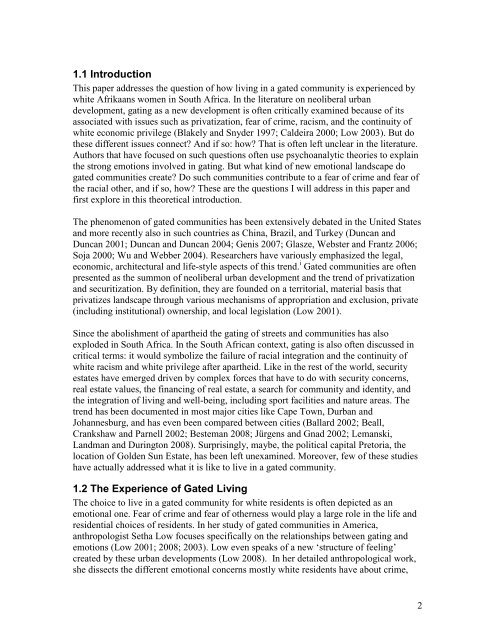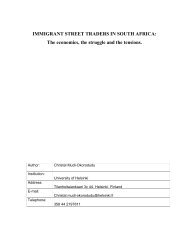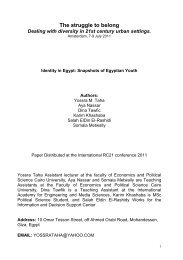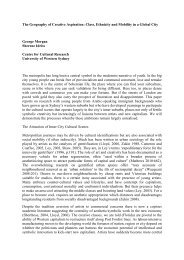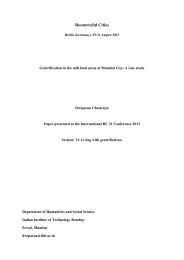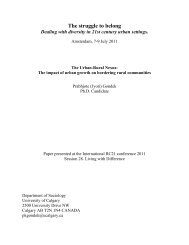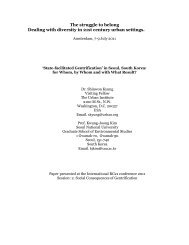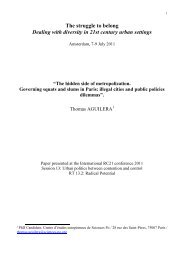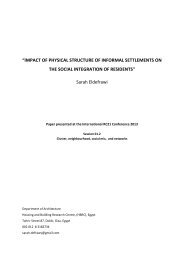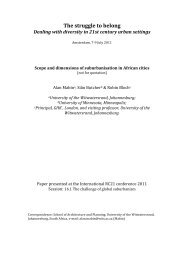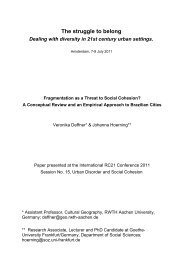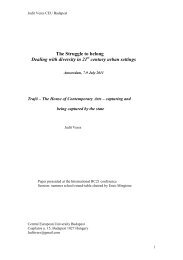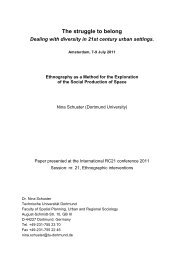White South Africans & The Experience of Gated Living in post ...
White South Africans & The Experience of Gated Living in post ...
White South Africans & The Experience of Gated Living in post ...
Create successful ePaper yourself
Turn your PDF publications into a flip-book with our unique Google optimized e-Paper software.
1.1 Introduction<br />
This paper addresses the question <strong>of</strong> how liv<strong>in</strong>g <strong>in</strong> a gated community is experienced by<br />
white Afrikaans women <strong>in</strong> <strong>South</strong> Africa. In the literature on neoliberal urban<br />
development, gat<strong>in</strong>g as a new development is <strong>of</strong>ten critically exam<strong>in</strong>ed because <strong>of</strong> its<br />
associated with issues such as privatization, fear <strong>of</strong> crime, racism, and the cont<strong>in</strong>uity <strong>of</strong><br />
white economic privilege (Blakely and Snyder 1997; Caldeira 2000; Low 2003). But do<br />
these different issues connect? And if so: how? That is <strong>of</strong>ten left unclear <strong>in</strong> the literature.<br />
Authors that have focused on such questions <strong>of</strong>ten use psychoanalytic theories to expla<strong>in</strong><br />
the strong emotions <strong>in</strong>volved <strong>in</strong> gat<strong>in</strong>g. But what k<strong>in</strong>d <strong>of</strong> new emotional landscape do<br />
gated communities create? Do such communities contribute to a fear <strong>of</strong> crime and fear <strong>of</strong><br />
the racial other, and if so, how? <strong>The</strong>se are the questions I will address <strong>in</strong> this paper and<br />
first explore <strong>in</strong> this theoretical <strong>in</strong>troduction.<br />
<strong>The</strong> phenomenon <strong>of</strong> gated communities has been extensively debated <strong>in</strong> the United States<br />
and more recently also <strong>in</strong> such countries as Ch<strong>in</strong>a, Brazil, and Turkey (Duncan and<br />
Duncan 2001; Duncan and Duncan 2004; Genis 2007; Glasze, Webster and Frantz 2006;<br />
Soja 2000; Wu and Webber 2004). Researchers have variously emphasized the legal,<br />
economic, architectural and life-style aspects <strong>of</strong> this trend. i <strong>Gated</strong> communities are <strong>of</strong>ten<br />
presented as the summon <strong>of</strong> neoliberal urban development and the trend <strong>of</strong> privatization<br />
and securitization. By def<strong>in</strong>ition, they are founded on a territorial, material basis that<br />
privatizes landscape through various mechanisms <strong>of</strong> appropriation and exclusion, private<br />
(<strong>in</strong>clud<strong>in</strong>g <strong>in</strong>stitutional) ownership, and local legislation (Low 2001).<br />
S<strong>in</strong>ce the abolishment <strong>of</strong> apartheid the gat<strong>in</strong>g <strong>of</strong> streets and communities has also<br />
exploded <strong>in</strong> <strong>South</strong> Africa. In the <strong>South</strong> African context, gat<strong>in</strong>g is also <strong>of</strong>ten discussed <strong>in</strong><br />
critical terms: it would symbolize the failure <strong>of</strong> racial <strong>in</strong>tegration and the cont<strong>in</strong>uity <strong>of</strong><br />
white racism and white privilege after apartheid. Like <strong>in</strong> the rest <strong>of</strong> the world, security<br />
estates have emerged driven by complex forces that have to do with security concerns,<br />
real estate values, the f<strong>in</strong>anc<strong>in</strong>g <strong>of</strong> real estate, a search for community and identity, and<br />
the <strong>in</strong>tegration <strong>of</strong> liv<strong>in</strong>g and well-be<strong>in</strong>g, <strong>in</strong>clud<strong>in</strong>g sport facilities and nature areas. <strong>The</strong><br />
trend has been documented <strong>in</strong> most major cities like Cape Town, Durban and<br />
Johannesburg, and has even been compared between cities (Ballard 2002; Beall,<br />
Crankshaw and Parnell 2002; Besteman 2008; Jürgens and Gnad 2002; Lemanski,<br />
Landman and Dur<strong>in</strong>gton 2008). Surpris<strong>in</strong>gly, maybe, the political capital Pretoria, the<br />
location <strong>of</strong> Golden Sun Estate, has been left unexam<strong>in</strong>ed. Moreover, few <strong>of</strong> these studies<br />
have actually addressed what it is like to live <strong>in</strong> a gated community.<br />
1.2 <strong>The</strong> <strong>Experience</strong> <strong>of</strong> <strong>Gated</strong> <strong>Liv<strong>in</strong>g</strong><br />
<strong>The</strong> choice to live <strong>in</strong> a gated community for white residents is <strong>of</strong>ten depicted as an<br />
emotional one. Fear <strong>of</strong> crime and fear <strong>of</strong> otherness would play a large role <strong>in</strong> the life and<br />
residential choices <strong>of</strong> residents. In her study <strong>of</strong> gated communities <strong>in</strong> America,<br />
anthropologist Setha Low focuses specifically on the relationships between gat<strong>in</strong>g and<br />
emotions (Low 2001; 2008; 2003). Low even speaks <strong>of</strong> a new ‗structure <strong>of</strong> feel<strong>in</strong>g‘<br />
created by these urban developments (Low 2008). In her detailed anthropological work,<br />
she dissects the different emotional concerns mostly white residents have about crime,<br />
2


